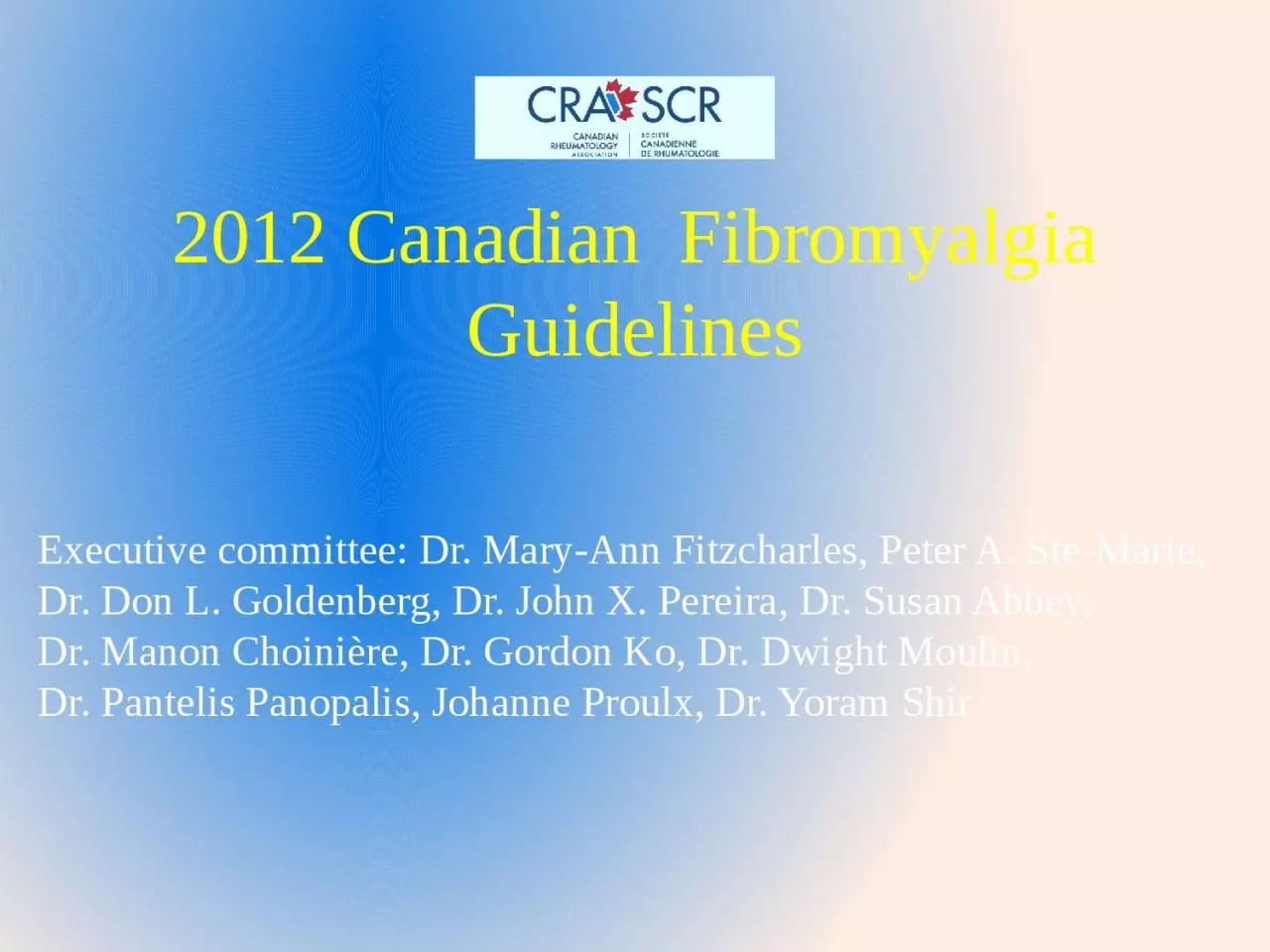

Executive committee Dr MaryAnn Fitzcharles Peter A Ste Marie Dr Don L Goldenberg Dr John X Pereira Dr Susan Abbey Dr Manon Choini ère Dr Gordon Ko Dr Dwight Moulin ID: 931118
Download Presentation The PPT/PDF document "2012 Canadian Fibromyalgia Guidelines" is the property of its rightful owner. Permission is granted to download and print the materials on this web site for personal, non-commercial use only, and to display it on your personal computer provided you do not modify the materials and that you retain all copyright notices contained in the materials. By downloading content from our website, you accept the terms of this agreement.
Slide1
2012 Canadian Fibromyalgia Guidelines
Executive committee: Dr. Mary-Ann Fitzcharles, Peter A. Ste-Marie, Dr. Don L. Goldenberg, Dr. John X. Pereira, Dr. Susan Abbey, Dr. Manon Choinière, Dr. Gordon Ko, Dr. Dwight Moulin, Dr. Pantelis Panopalis, Johanne Proulx, Dr. Yoram Shir
Slide2Why develop Guidelines?
Recent guidelines ±10 years oldAdvances in understanding FMNeurophysiologicTreatmentsNew diagnostic criteria (ACR 2010)Call for guidance & directionRequested by Canadian Pain Society
Slide3Objectives
To provide Canadian healthcare professionals clinically applicable guidelines for use in daily practiceDiagnosisManagementPatient trajectory
Slide4Makeup of guideline group
Executive committee:11 personsHealth care professionals, international expert, project coordinator, patient representativeNational Fibromyalgia Guideline Advisory Panel (NFGAP)139 healthcare professionals invited35 agreed to participate and completed voting processAll healthcare professionals active in the care of FM and chronic pain patients.
Slide5Methods
Step 1: Needs assessmentStep 2: Literature searchStep 3: Grading of evidenceStep 4: WritingStep 5: Advisory Panel votes on recommendationsStep 6: External RevisionStep 7: Publication & Dissemination
Slide6Financial support &
conflicts of interestGuideline development requested by CPSLouise and Alan Edwards FoundationResearch assistant: salary supportAll participants stated conflicts of interestNeeds assessmentUnrestricted educational grant by Valeant without any input to contentNo additional industry support
Slide7The literature search
18 key questionsMcGill Librarians did formal lit searchEmbase, MEDLINE, PsychInfo, Pubmed, Cochrane, grey literature, hand search>5000 articlesTitles, abstracts reviewed, duplicates removed360 retained
Slide8How we did the job
18 questions & 360 articles Each article read graded (JADAD) level of evidence (Oxford)Literature is summarized in three sectionsRecommendations are formulated by the Executive committee, assigned a level of evidence and a grade.
Slide9Methods: Assessing individual studies
Grading of individual articles was by JADAD method (out of 5):Was the study described as randomized? Was the study described as double blind?Was there a description of withdrawals and dropouts? The method of randomization was described in the paper, and that method was appropriate. The method of blinding was described, and it was appropriate. Points deducted if:The method of randomization was described, but was inappropriate.
The method of blinding was described, but was inappropriate.
Slide10Assigning a level of evidence
for each recommendationOverview of the Oxford Centre for Evidence Based Medicine (level of evidence table)Level 1Level 2
Level
3
Level 4
Level 5
Systematic review of
RCTs
RCT
(or observational studies
with dramatic
effect)
Non-RCT cohort/follow-up
study
case-control
studies, historically controlled studies
Opinion
Slide11Grading of recommendations
Aconsistent level 1 studies Bconsistent level 2 or 3 studies or extrapolations from level 1 studiesC
level 4 studies or extrapolations from level 2 or 3 studies
D
level 5 evidence or troublingly inconsistent or inconclusive studies of any level
* Level may be graded down
or up by experts
Slide1246 recommendations formulated
NFGAP voting process:SurveyMonkey usedAdvisors had access to full document Voted in three sections:RecommendationGrading of recommendation80% required for acceptance
Slide13Guidelines address three broad concepts
Diagnosis and evaluation 12Management 23Patient trajectory and follow-up 11new clinical concepts regarding FM have been incorporated into these guidelines.
Slide14Where we currently stand
44 page document (12 000 words)336 referencesEndorsed by Canadian Pain Society and Canadian Rheumatology Association.Publication & dissemination in progress
Slide15The diagnosis
Composite of symptoms (level 5)2/3 pain1/3 other (Sleep disturbance, fatigue, cognitive dysfunction..)Diagnosis (level 5)Clinical constructSimple blood tests onlyPhysical exam must be done (level 5)Exclude other conditionsTender points not required
Slide16Diagnosis (cont.)
As early as possible (level 5)Primary care is ideal setting (level 1)Access to team member for support (level 3)Specialist referral only if (level 5)Atypical symptomsDifficulties in managementeg. sleep specialist, psychologist
Slide17Diagnosis (cont.)
Healthcare professionalsneed education (level 5)Empathetic, shared decision-making (level 3) Contributing factors such as genetics or triggering events must not hinder care(level 5)ACR 2010 criteria (level 3)May validate clinical diagnosis
Slide18Management (overview)
No ideal treatmentPatient tailored approach (level 5)Symptom-based managementNon-pharmacologic & pharmacologic strategiesAim to symptomsMaintain / improve function
Slide19Management(overview cont.)
Self-management strategies are imperative (level 1)Patient active participant!! (level 1)Multimodal approach (level 1)Realistic goals (level 5)Pacing, but continue normal life (level 4)
Slide20Management(psychological interventions)
Internal locus of controlRecognize psychological distress (level 3)Patient education – better coping skills (level 5)Improve self-efficacy (level 1)Psych counselling helpful for some (level 5)CBT (level 1)
Slide21Management (non-pharmacologic)
Exercise (level 1)Best available evidence Any type aerobics, water based, stretching, etc.CAM Insufficient evidence (level 1)Encourage disclosure of use (level 5)
Slide22Management
(pharmacologic)No perfect drugLowest dose, gradual increase (level 5)Expect only a modest responseConsider combination drugs (level 5)Be knowledgeable regarding drug mechanisms (level 5)Constant evaluation re risk vs. benefit (level 5)
Slide23Management(pharmacologic cont.)
WHO step-up analgesic ladder (level 5)NSAIDS – low dose, short use (level 5)Tramadol – moderate/severe pain (level 2)Strong opioids – discouraged (level 5)Cannabinoid (pharma) – sleep (level 3)
Slide24Management(pharmacologic cont.)
AntidepressantsExplain mechanism to patient (level 5)TCAs, SSRIs & SNRIs can be used (level 1)Choice – MD knowledge, Pt characteristics (level 5)AnticonvulsantsExplain mechanism to patient (level 5)Low dose (level 1)
Slide25Patient trajectory
Follow-up time interval depends on MD judgment (level 5)New symptomsEvaluate using clinical judgment (level 5)FM symptoms persist, wax and wane (level 3)No value to dwell on past lifetime events, move forward (level 5)
Slide26Patient trajectory (continued)
Poor outcome when (level 5)Passive patientExternal locus of controlUntreated prominent mood disorderOutcome toolsPatient Global Impression of Change (level 3)Goal attainment (level 5)Do not use tender points for outcome (level 3)
Slide27Patient trajectory (work & costs)
Retention in workforce encouraged (level 3)Rehab program if necessary (level 5)Reduce costs by treating depression (level 3)
Slide28Key points…
Clinical constructPrimary setting is recommendedDo not over medicalize patientNon-pharma strategies VIPPatient ownershipSymptom-based managementNo ideal drugDrugs show modest effects onlyEncourage retention in workforce
Slide29Thank you!!
Any questions?